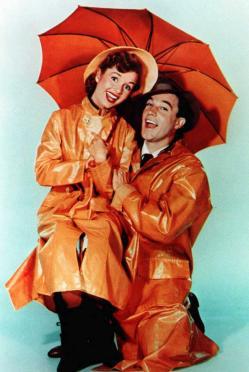Gene Kelly, one of the biggest stars and greatest innovators from Hollywood’s golden age of musicals, would have been 100 years old today. Kelly’s signature turn (and turns) in the 1952 musical Singin’ in the Rain have inspired everything from a creepy reimagining of his iconic performance in a Volkswagen commercial to a “Greatest Number of People Simultaneously Performing an Umbrella Dance at a Single Venue” attempt in honor of his centennial. But his influence is most pervasive in the world of dance. From Broadway to music videos, R&B concerts to the big screen, choreographers of all stripes still draw on the work of Gene Kelly.
Choreographer Andy Blankenbuehler was inspired by Kelly’s “low-to-the-floor” and “athletic” style while working on In the Heights, for instance, which won him a Tony. While the show’s score was influenced by Latin music and hip hop, its dance routines were shaped, in part, by Gene Kelly.
Kelly called his own style a “hybrid” of various approaches to dance, including modern, ballet, and tap. His work with choreographer Robert Alton on the original production of Pal Joey—Alton would innovatively break up the chorus line into soloists and small groups—was a source of inspiration throughout Kelly’s career, as were his brief experiences watching and working with black dancers Frank Harrington and Dancing Dotson. This eclectic mix of styles can be seen in the way Kelly moves effortlessly between hoofing, lyrical steps, acrobatics, and jazz dance—as in “Good Morning” from Singin’ in the Rain, or the 16-minute ballet sequence “An American in Paris.”
Kelly’s legacy can also be found all over music videos. The photographer Mike Salisbury shot Michael Jackson for the cover of Off the Wall in the “Gene Kelly white sox [sic] and loafers”—a signature look for the movie star, which would soon become the singer’s own recognizable brand (with added sparkle). Just a few years later, Jackson and Paul McCartney paid homage to Kelly and Singin’ in the Rain co-star Donald O’Connor in their video for “Say Say Say,” which features outfits almost identical to the Singin’ number “Fit as a Fiddle.” Paula Abdul, first known primarily for her dancing and choreography, referenced Kelly’s famous dance with Jerry the Mouse in her kitschy video for “Opposites Attract,” which includes a final tap-dance breakdown.
Kelly also embraced stunts and acrobatics. One of his most physically demanding films, The Pirate, included “Be a Clown,” a performance with the renowned Nicholas Brothers—who, as black performers in a time of limited opportunity, never got their full artistic due—and a ballet that finds him swinging from the “sails” of a ship and dancing with a giant baton. Usher, who has paid explicit tribute to Kelly, and his direct descendant, Chris Brown, show Kelly’s influence in their athletic displays, incorporating flips and leaps upon giant stage sets into their routines.
Director Kenny Ortega—who choreographed Kelly in Xanadu, his last big screen role—called Kelly his mentor at a 100th Birthday event for Kelly back in May. The star’s influence shines in much of Ortega’s work, from Patrick Swayze’s macho moves in Dirty Dancing to his kid-friendly High School Musical franchise. In the second installment of that Disney trilogy, an energetic dance number on a baseball field draws a direct line to one of Kelly’s greatest artistic crusades: to show that guys who play sports could and should enjoy dance, which is itself an athletic activity. Kelly showcased this most notably in a 1958 television special called Dancing is a Man’s Game, which featured boxer Sugar Ray Robinson. While there will never be another like Kelly, his work continues to resonate with generation after generation of American dancers.
Further listening: A discussion of Gene Kelly on this week’s Culture Gabfest.
